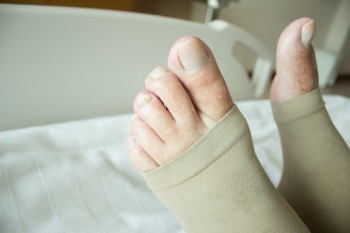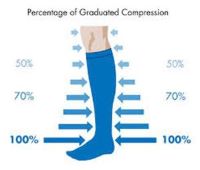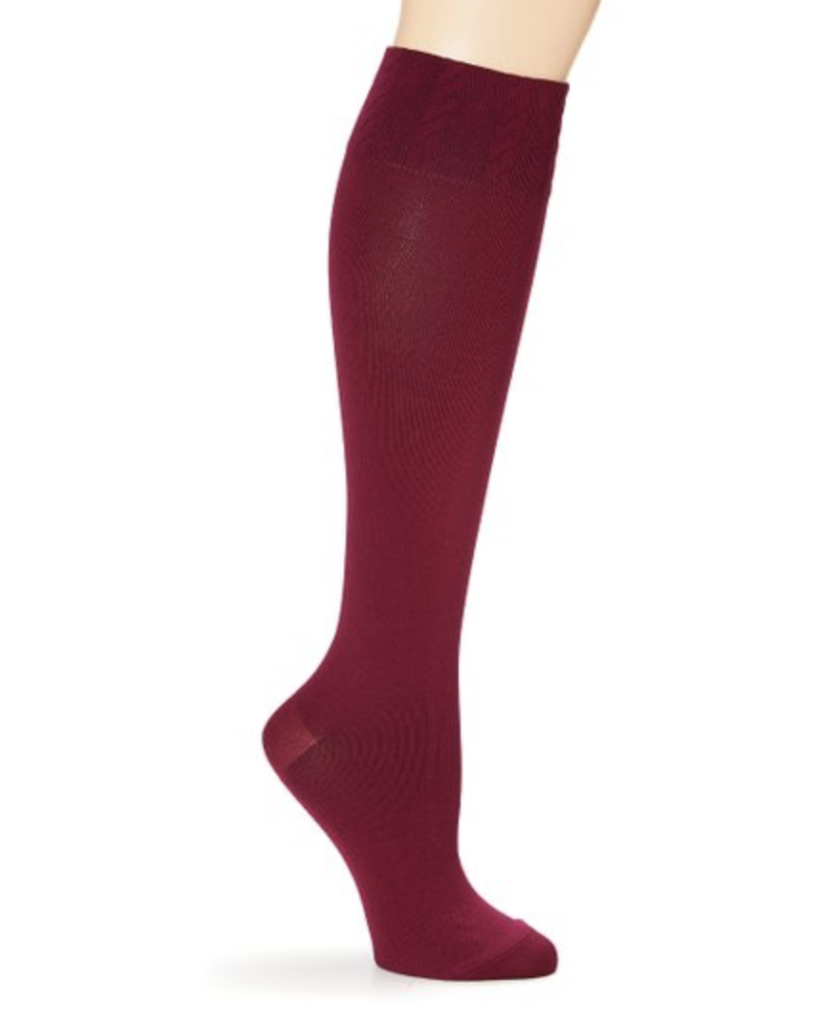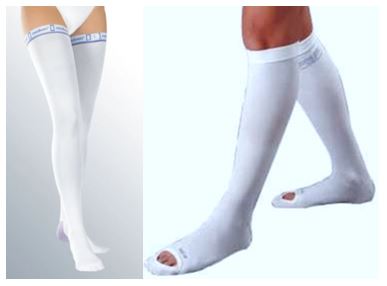TED Hose vs. Compression Stockings – What’s the difference?
Doctors regularly prescribe lower extremity compression to individuals that need help preventing conditions such as blood clots, edema or deep vein thrombosis (DVT). Both TED hose and compression stockings can prevent blood clotting, so how do you know which type of compression garment is better for you?
In this article we’ll explore the differences between TED hose and compression stockings to answer that question.

TED Hose vs. Compression Stockings – Why the Difference Matters

Using compression garments to increase pressure on the lower extremities is an important part of recovery, prevention and treatment for many patients. TED hose, also known as anti-embolism stockings, are frequently confused with regular compression socks.
Though both work in similar ways and can be worn to prevent blood clotting, the similarities end there.
You will be startled to discover that many people (healthcare experts included) mistakenly view all compression garments as interchangeable with TED hose. Healthcare professionals, caregivers and patients must be able to differentiate between these two main types of compression garments for both safety and effectiveness.
For the last twenty years, I have been in the medical field and have regularly seen the confusion around TED socks firsthand. I cannot tell you how many times I have arrived to a new healthcare or rehabilitation job only to discover that nearly half of the patients were wearing the wrong compression garments.
To get the optimal results from your compression wear, you must understand whether compression stockings or anti-embolism TED hose are the best option for your circumstance. These two garments are truly different. After reading this article, you will have a clear understanding of the differences. Let’s take a peek.
TED Hose vs. Compression Stockings – Definitions
TED Hose

In the medical field, TED hose may be referred to as thromboembolic deterrent hose or anti-embolism stockings. They are specifically designed to apply pressure to the superficial veins of the legs in order to prevent the formation of blood clots.
TED hose apply light and graduated compression along the leg. They are meant for people who are immobile and bedridden. For example, someone recovering from a hip replacement would benefit from wearing TED hose.
Compression Stockings

These are close-fitting stockings or socks designed to apply a specific level of pressure on the lower extremities. They range in pressure levels, beginning at 15mmHg all the way up to 50mmHg.
Since compression stockings can apply such high levels of pressure to the veins, they are an excellent therapeutic tool for managing many venous conditions.
People who are active or who stand for extended periods of time can also benefit from mid-range compression. Athletes, nurses and service industry workers may all wear compression socks or stockings to improve their level of energy and prevent heaviness in the legs.
TED Hose vs. Compression Stockings – What’s the Difference?
Although both of these specialized compression garments can look similar, there are many differences when it comes to their use and design.

1. Purpose
TED Hose

TED stockings are solely for the purpose of preventing blood clots or embolism in non-ambulatory (immobile) or post-operative patients. They achieve this by keeping the blood flowing at a healthy rate, thereby preventing blood from accumulating or pooling in the patient’s leg.
This minimizes the chances of blood clots. Without healthy circulation, the blood can become thicker and coagulate in the legs, leading to venous thrombosis or thromboembolism (DTV).
Blood clots can pose a serious health risk to the patient when they dislodge from the leg vein and are transported by the blood to the lungs and heart. They can block the capillaries leading to the lungs or become lodged in the heart, a potentially fatal condition called pulmonary embolism (PE).
Popular Articles on ComproGear
How Long to Wear Compression Socks for Edema Edema Compression Socks Before and After
Compression Leg Sleeves Medical Compression Sleeves for Legs
Graduated Compression Leggings Graduated Compression Tights
Best Compression Socks for Standing All Day Do Compression Socks Help with Standing All Day?
Compression Socks
A key difference between these two compression hose is that compression socks are prescribed explicitly for ambulatory (mobile) patients, not immobile patients like TED socks are. Compression socks are designed to enhance blood flow in the lower extremities for reasons outside of solely preventing blood clots. Unlike TED hose, compression stockings can be used for conditions that require aggressive pressure to be treated.
The utilization of compression stockings is a vital part of treatment for conditions such as:
- Lymphedema (accumulation of lymph that causes swelling).
- Venous deficiency.
- Varicosity (varicose veins).
Apart from the treatment of the above conditions, they also help in the prevention of:
- Orthostatic hypotension (unsteadiness when standing).
- Venous ulcers
- Venous hypertension
2. Level of Compression
TED Hose
For both TED hose and compression stockings, the level of pressure is calibrated in mmHg (millimeters of mercury). Between these two compression garments, TED socks have the lowest compression level, usually between 8-18mmHg.
Compression Socks
On the other hand, the level of applied pressure for compression socks is categorized into several primary compression levels:

- 15-20mmHg (Over-the-Counter).
- 20-30mmHg (Medical Class 1).
- 30-40mmHg (Medical Class 2).
- 40-50mmHg (Medical Class 3).
For patients to acquire compression stockings with pressure levels higher than 20mmHg, a prescription must be obtained from a physician.
There are also health concerns to consider when it comes to compression stockings. For instance, improper use of compression socks can cause peripheral nerve damage. And for patients with impaired arterial flow, the use of compression stockings can cause insufficient oxygenated blood flow and exacerbate ischemia.
3. Design
TED Hose

TED hose is primarily available as a white knee-high or thigh-high sock. These socks are designed with a small opening that exposes the toes, an “inspection hole” for monitoring the patient’s blood circulation.
TED hose are not made with walking or movement in mind. They may slide down the legs or bunch up at the feet as you walk.
Compression Socks
Compression socks and stockings are available in many different colors, patterns and styles. The main types of compression stockings you’ll find on the market are graduated compression stockings and non-medical support hosiery / support hose. These can be found as open-toe, thigh-high, knee-high or footless versions of compression stockings.

- Graduated Compression Stockings
Graduated compression socks have the highest level of compression at the ankle. The pressure applied by the sock decreases gradually as you move up to the top of the sock.
Graduated compression stockings will need a professional fitting. Some suppliers provide custom styles in terms of closed- or open-toe designs and color.

- Nonmedical Support Hosiery
This type of compression stocking usually doesn’t need a doctor’s prescription. They encompass flight socks and elastic support stockings used to relieve tired and aching limbs.
They are not graduated and therefore offer minimal, uniform pressure in comparison to prescription compression socks.
4. Duration of Use
Popular Articles on ComproGear
Rose toy not your average vibrator
TED Hose

Generally, TED hose is used for short-term compression needs. Patients may wear TED hose for a maximum of three weeks, or until another form of preventing blood clots may be utilized such as in-bed exercises and movement.
Compression Socks

Compression stockings are generally recommended for daily use for a maximum of six months, but this depends on the recommendations from your physician.
If you wear your compression socks less frequently, like before or after workouts rather than all day, there is no maximum limit to days of wear.
Either way, choose a pair that fits properly.
TED Hose vs. Compression Stockings – Summary
| TED Hose | Compression Stockings |
| Meant to prevent the formation of blood clots. | Meant to enhance the flow of blood in the lower extremities to prevent blood clots, varicose veins, orthostatic hypotension, edema, venous ulcers, venous insufficiency, etc. |
| Designed for non-ambulatory (immobile) or post-operative patients. | Designed for ambulatory (mobile) individuals suffering from venous health conditions. |
| Has a compression level of around 8-18mmHG. | The compression levels include multiple categories: 15-20mmHg, 20-30mmHg, 30-40mmHg and 40-50mmHg. |
| Only available in white. They have a small opening that exposes the toes. | Found in a wide range of colors and styles. |
| The recommended period of use is three weeks. | Recommended period of use is for up to six months, depending on your physician’s recommendations. |

In conclusion, it is crucial for patients to have basic information about the tools used in their treatment. A simple rule of thumb that practitioners and patients should know regarding compression garments is:
If the patient is ambulatory (Walking/Sitting) they should wear Compression Socks.
If the patient is non-ambulatory (Bed Bound) they should TED Hose.
This page last updated November 5, 2022
